BTEC HND Computing: System Analysis and Design - SDLC Models Report
VerifiedAdded on 2023/06/13
|25
|5614
|299
Report
AI Summary
This report provides a comprehensive analysis of system analysis and design principles, focusing on the evaluation of various Software Development Life Cycle (SDLC) models such as Waterfall, Iterative, Spiral, Prototype, and Agile, comparing their advantages and disadvantages. It also discusses the significance of SDLC in the investigation of developing systems, highlighting stages like preliminary investigation, requirement analysis, designing, coding, testing, implementation, and maintenance. Furthermore, the report delves into the components of a feasibility report, including economic, technical, operational, time, legal, social, and management feasibility, investigating their effects on system development. The report includes an overview of a proposed system with ERD and DFD diagrams, system-specific requirements, external interfaces, software and hardware interfaces, user interfaces, functional and non-functional requirements, and user system requirements evaluation through verification and validation. Desklib offers a wealth of similar assignments and past papers for students seeking to enhance their understanding.

System Analysis and
Design
Design
Paraphrase This Document
Need a fresh take? Get an instant paraphrase of this document with our AI Paraphraser

Table of Contents
1. Task 1................................................................................................................................................2
1.1 Evaluation of various systems lifecycle models.............................................................2
1.2 Discussion about the significance of software development life cycle in
investigation of developing system...............................................................................................7
2. Task 2................................................................................................................................................7
2.1 Discussion on the components of a feasibility report...................................................7
2.2 Investigating the effects of various feasibility criteria towards developing system
9
3. Task 1..............................................................................................................................................11
3.1 Introduction............................................................................................................................11
3.1.1 Aim...................................................................................................................................11
3.1.2 Project Scope.................................................................................................................11
3.1.3 Abbreviations, Acronyms and Definitions..............................................................12
3.1.4 Overview of the Project...............................................................................................12
3.2 Overall Description of Proposed System........................................................................12
3.2.1 General Description about Project...........................................................................12
3.2.2 Hardware Interfaces.....................................................................................................12
3.2.3 Software Interfaces.......................................................................................................12
3.2.4 Product capabilities......................................................................................................13
3.3 ERD..........................................................................................................................................14
3.3.1 Context Level DFD........................................................................................................14
3.3.2 Data flow Diagram.........................................................................................................15
3.4 System Specific Requirements.........................................................................................19
3.4.1 External Interfaces of Proposed System.................................................................19
3.4.2 Software Interfaces.......................................................................................................19
3.4.3 Hardware Interfaces.....................................................................................................19
3.4.4 User Interfaces...............................................................................................................19
3.4.5 Functional Requirements............................................................................................19
3.4.6 Non-functional Requirements....................................................................................21
3.4.7 Evaluation of User System Requirements through Verification and Validation
Process 21
1
1. Task 1................................................................................................................................................2
1.1 Evaluation of various systems lifecycle models.............................................................2
1.2 Discussion about the significance of software development life cycle in
investigation of developing system...............................................................................................7
2. Task 2................................................................................................................................................7
2.1 Discussion on the components of a feasibility report...................................................7
2.2 Investigating the effects of various feasibility criteria towards developing system
9
3. Task 1..............................................................................................................................................11
3.1 Introduction............................................................................................................................11
3.1.1 Aim...................................................................................................................................11
3.1.2 Project Scope.................................................................................................................11
3.1.3 Abbreviations, Acronyms and Definitions..............................................................12
3.1.4 Overview of the Project...............................................................................................12
3.2 Overall Description of Proposed System........................................................................12
3.2.1 General Description about Project...........................................................................12
3.2.2 Hardware Interfaces.....................................................................................................12
3.2.3 Software Interfaces.......................................................................................................12
3.2.4 Product capabilities......................................................................................................13
3.3 ERD..........................................................................................................................................14
3.3.1 Context Level DFD........................................................................................................14
3.3.2 Data flow Diagram.........................................................................................................15
3.4 System Specific Requirements.........................................................................................19
3.4.1 External Interfaces of Proposed System.................................................................19
3.4.2 Software Interfaces.......................................................................................................19
3.4.3 Hardware Interfaces.....................................................................................................19
3.4.4 User Interfaces...............................................................................................................19
3.4.5 Functional Requirements............................................................................................19
3.4.6 Non-functional Requirements....................................................................................21
3.4.7 Evaluation of User System Requirements through Verification and Validation
Process 21
1
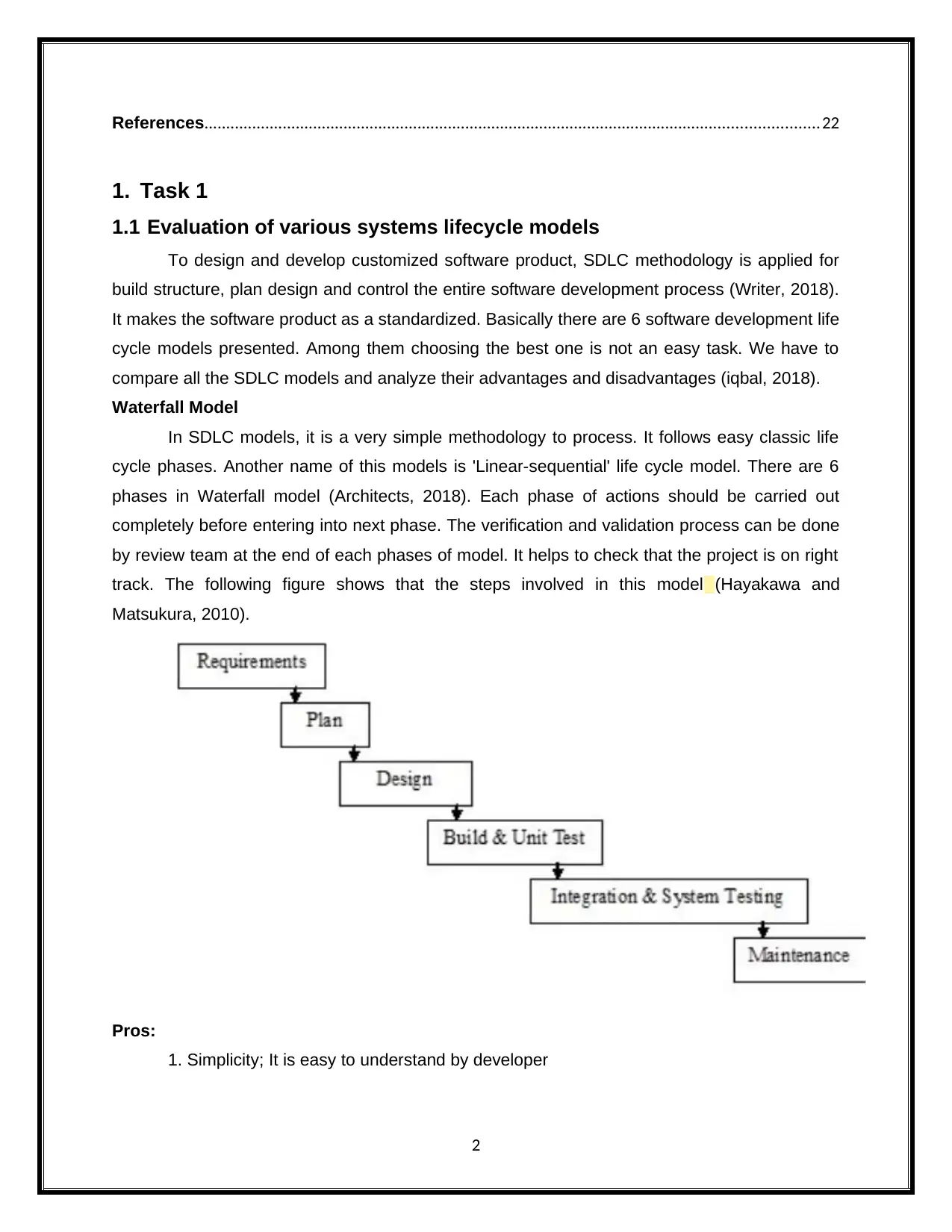
References.............................................................................................................................................22
1. Task 1
1.1 Evaluation of various systems lifecycle models
To design and develop customized software product, SDLC methodology is applied for
build structure, plan design and control the entire software development process (Writer, 2018).
It makes the software product as a standardized. Basically there are 6 software development life
cycle models presented. Among them choosing the best one is not an easy task. We have to
compare all the SDLC models and analyze their advantages and disadvantages (iqbal, 2018).
Waterfall Model
In SDLC models, it is a very simple methodology to process. It follows easy classic life
cycle phases. Another name of this models is 'Linear-sequential' life cycle model. There are 6
phases in Waterfall model (Architects, 2018). Each phase of actions should be carried out
completely before entering into next phase. The verification and validation process can be done
by review team at the end of each phases of model. It helps to check that the project is on right
track. The following figure shows that the steps involved in this model (Hayakawa and
Matsukura, 2010).
Pros:
1. Simplicity; It is easy to understand by developer
2
1. Task 1
1.1 Evaluation of various systems lifecycle models
To design and develop customized software product, SDLC methodology is applied for
build structure, plan design and control the entire software development process (Writer, 2018).
It makes the software product as a standardized. Basically there are 6 software development life
cycle models presented. Among them choosing the best one is not an easy task. We have to
compare all the SDLC models and analyze their advantages and disadvantages (iqbal, 2018).
Waterfall Model
In SDLC models, it is a very simple methodology to process. It follows easy classic life
cycle phases. Another name of this models is 'Linear-sequential' life cycle model. There are 6
phases in Waterfall model (Architects, 2018). Each phase of actions should be carried out
completely before entering into next phase. The verification and validation process can be done
by review team at the end of each phases of model. It helps to check that the project is on right
track. The following figure shows that the steps involved in this model (Hayakawa and
Matsukura, 2010).
Pros:
1. Simplicity; It is easy to understand by developer
2
⊘ This is a preview!⊘
Do you want full access?
Subscribe today to unlock all pages.

Trusted by 1+ million students worldwide
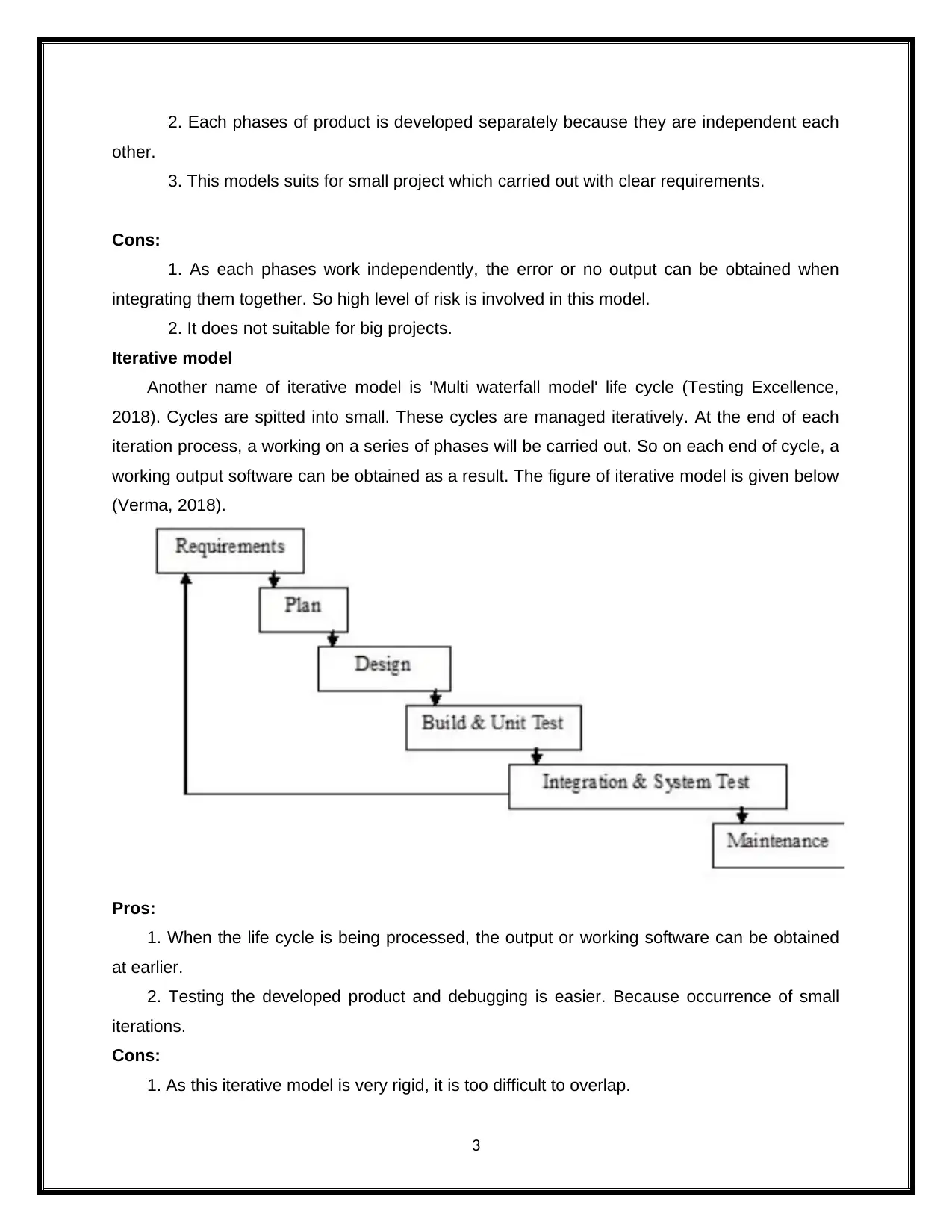
2. Each phases of product is developed separately because they are independent each
other.
3. This models suits for small project which carried out with clear requirements.
Cons:
1. As each phases work independently, the error or no output can be obtained when
integrating them together. So high level of risk is involved in this model.
2. It does not suitable for big projects.
Iterative model
Another name of iterative model is 'Multi waterfall model' life cycle (Testing Excellence,
2018). Cycles are spitted into small. These cycles are managed iteratively. At the end of each
iteration process, a working on a series of phases will be carried out. So on each end of cycle, a
working output software can be obtained as a result. The figure of iterative model is given below
(Verma, 2018).
Pros:
1. When the life cycle is being processed, the output or working software can be obtained
at earlier.
2. Testing the developed product and debugging is easier. Because occurrence of small
iterations.
Cons:
1. As this iterative model is very rigid, it is too difficult to overlap.
3
other.
3. This models suits for small project which carried out with clear requirements.
Cons:
1. As each phases work independently, the error or no output can be obtained when
integrating them together. So high level of risk is involved in this model.
2. It does not suitable for big projects.
Iterative model
Another name of iterative model is 'Multi waterfall model' life cycle (Testing Excellence,
2018). Cycles are spitted into small. These cycles are managed iteratively. At the end of each
iteration process, a working on a series of phases will be carried out. So on each end of cycle, a
working output software can be obtained as a result. The figure of iterative model is given below
(Verma, 2018).
Pros:
1. When the life cycle is being processed, the output or working software can be obtained
at earlier.
2. Testing the developed product and debugging is easier. Because occurrence of small
iterations.
Cons:
1. As this iterative model is very rigid, it is too difficult to overlap.
3
Paraphrase This Document
Need a fresh take? Get an instant paraphrase of this document with our AI Paraphraser
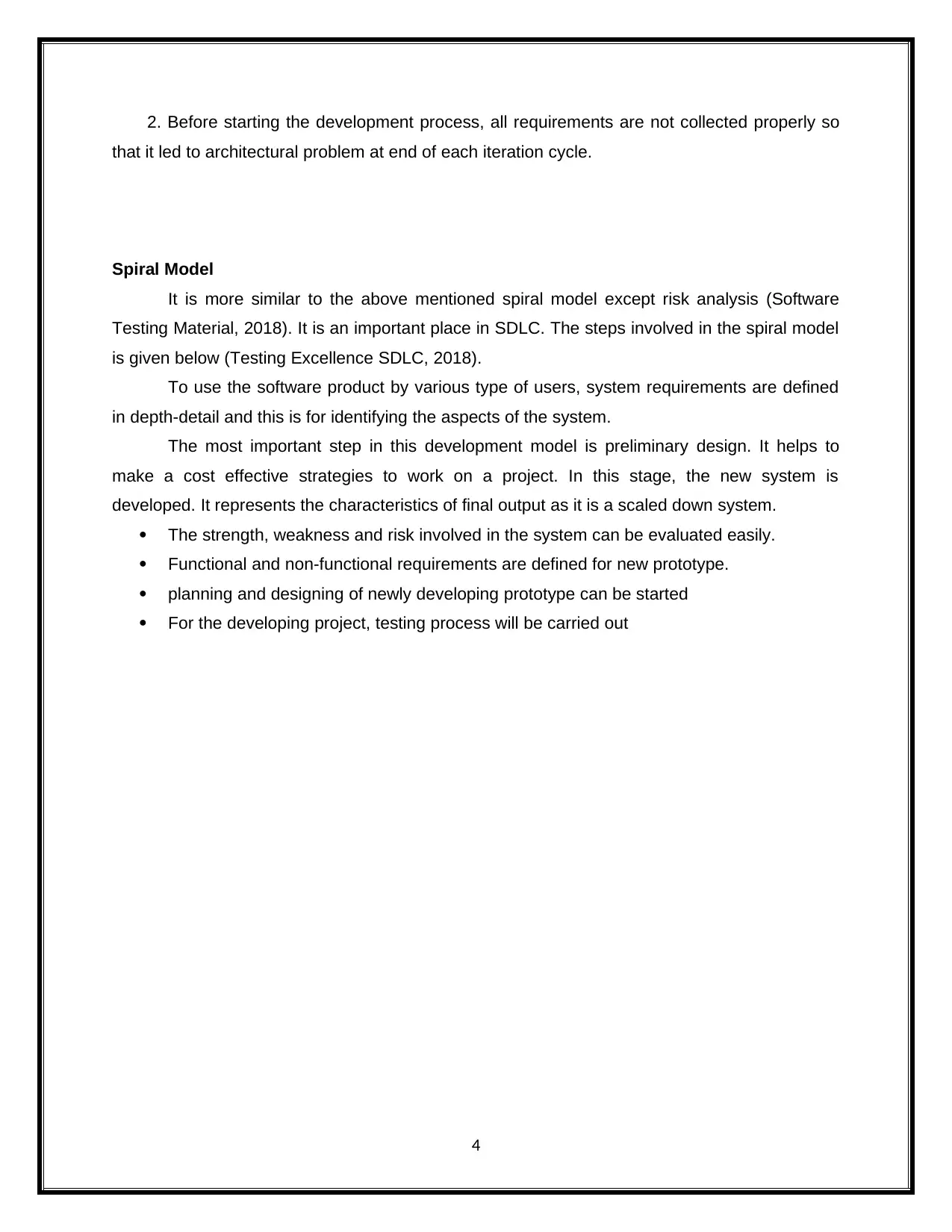
2. Before starting the development process, all requirements are not collected properly so
that it led to architectural problem at end of each iteration cycle.
Spiral Model
It is more similar to the above mentioned spiral model except risk analysis (Software
Testing Material, 2018). It is an important place in SDLC. The steps involved in the spiral model
is given below (Testing Excellence SDLC, 2018).
To use the software product by various type of users, system requirements are defined
in depth-detail and this is for identifying the aspects of the system.
The most important step in this development model is preliminary design. It helps to
make a cost effective strategies to work on a project. In this stage, the new system is
developed. It represents the characteristics of final output as it is a scaled down system.
The strength, weakness and risk involved in the system can be evaluated easily.
Functional and non-functional requirements are defined for new prototype.
planning and designing of newly developing prototype can be started
For the developing project, testing process will be carried out
4
that it led to architectural problem at end of each iteration cycle.
Spiral Model
It is more similar to the above mentioned spiral model except risk analysis (Software
Testing Material, 2018). It is an important place in SDLC. The steps involved in the spiral model
is given below (Testing Excellence SDLC, 2018).
To use the software product by various type of users, system requirements are defined
in depth-detail and this is for identifying the aspects of the system.
The most important step in this development model is preliminary design. It helps to
make a cost effective strategies to work on a project. In this stage, the new system is
developed. It represents the characteristics of final output as it is a scaled down system.
The strength, weakness and risk involved in the system can be evaluated easily.
Functional and non-functional requirements are defined for new prototype.
planning and designing of newly developing prototype can be started
For the developing project, testing process will be carried out
4
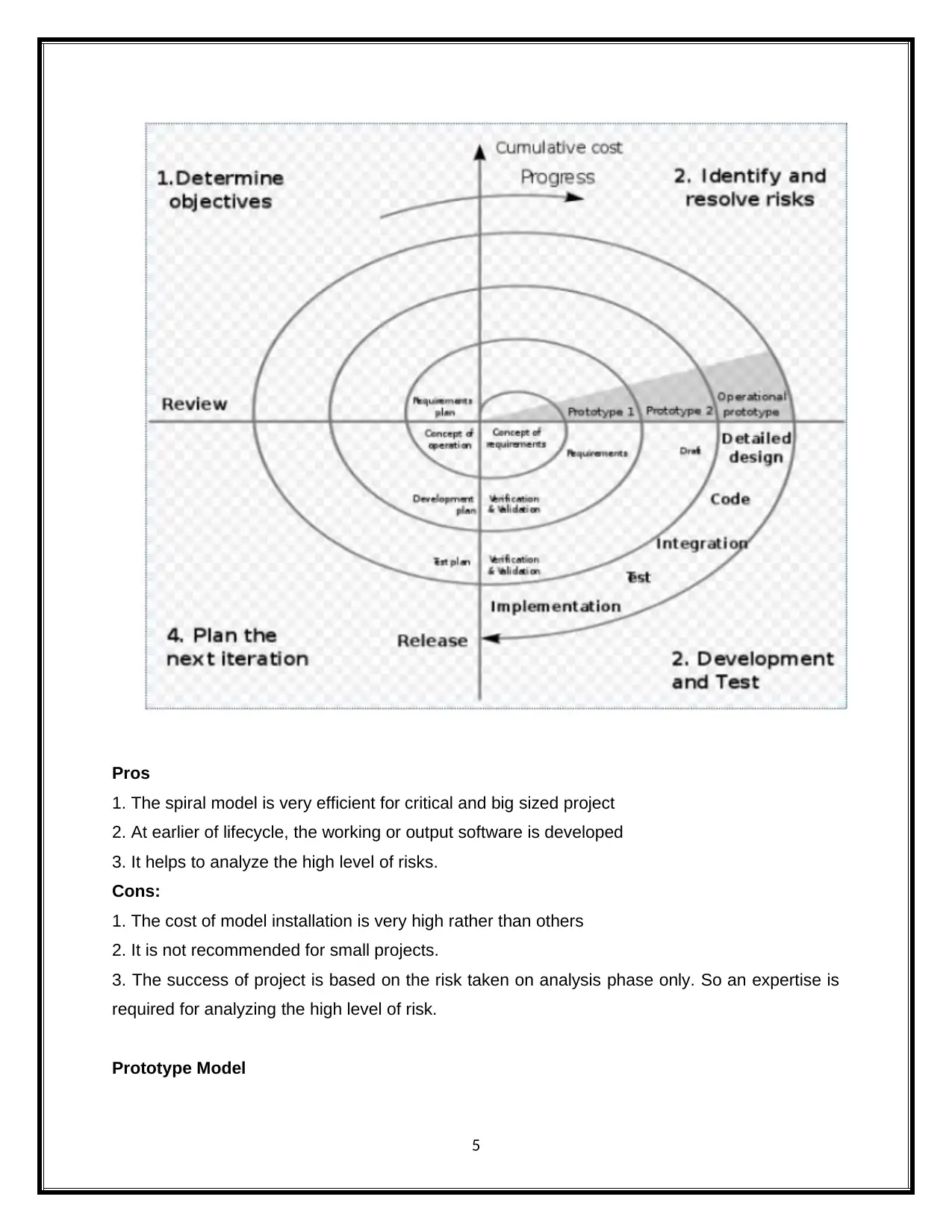
Pros
1. The spiral model is very efficient for critical and big sized project
2. At earlier of lifecycle, the working or output software is developed
3. It helps to analyze the high level of risks.
Cons:
1. The cost of model installation is very high rather than others
2. It is not recommended for small projects.
3. The success of project is based on the risk taken on analysis phase only. So an expertise is
required for analyzing the high level of risk.
Prototype Model
5
1. The spiral model is very efficient for critical and big sized project
2. At earlier of lifecycle, the working or output software is developed
3. It helps to analyze the high level of risks.
Cons:
1. The cost of model installation is very high rather than others
2. It is not recommended for small projects.
3. The success of project is based on the risk taken on analysis phase only. So an expertise is
required for analyzing the high level of risk.
Prototype Model
5
⊘ This is a preview!⊘
Do you want full access?
Subscribe today to unlock all pages.

Trusted by 1+ million students worldwide
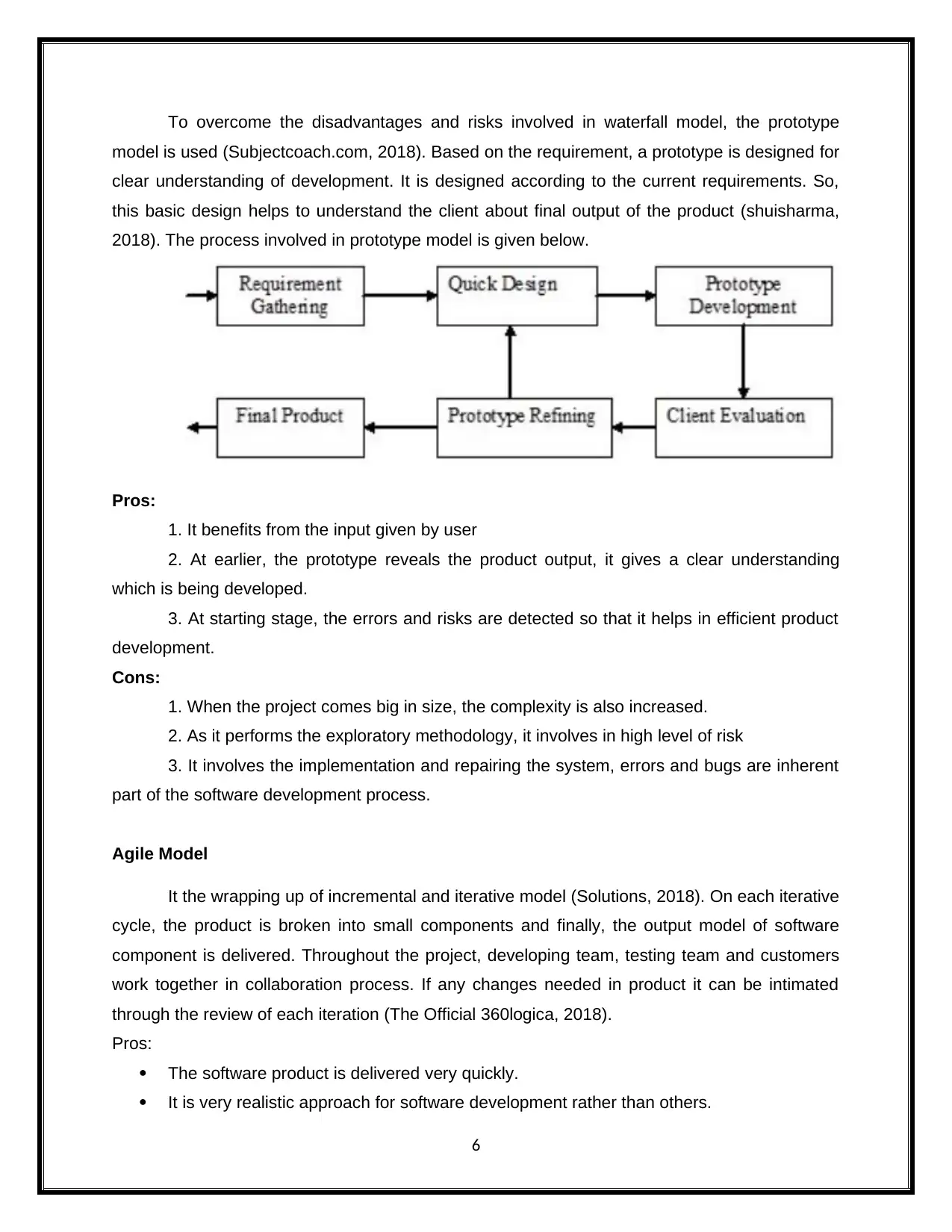
To overcome the disadvantages and risks involved in waterfall model, the prototype
model is used (Subjectcoach.com, 2018). Based on the requirement, a prototype is designed for
clear understanding of development. It is designed according to the current requirements. So,
this basic design helps to understand the client about final output of the product (shuisharma,
2018). The process involved in prototype model is given below.
Pros:
1. It benefits from the input given by user
2. At earlier, the prototype reveals the product output, it gives a clear understanding
which is being developed.
3. At starting stage, the errors and risks are detected so that it helps in efficient product
development.
Cons:
1. When the project comes big in size, the complexity is also increased.
2. As it performs the exploratory methodology, it involves in high level of risk
3. It involves the implementation and repairing the system, errors and bugs are inherent
part of the software development process.
Agile Model
It the wrapping up of incremental and iterative model (Solutions, 2018). On each iterative
cycle, the product is broken into small components and finally, the output model of software
component is delivered. Throughout the project, developing team, testing team and customers
work together in collaboration process. If any changes needed in product it can be intimated
through the review of each iteration (The Official 360logica, 2018).
Pros:
The software product is delivered very quickly.
It is very realistic approach for software development rather than others.
6
model is used (Subjectcoach.com, 2018). Based on the requirement, a prototype is designed for
clear understanding of development. It is designed according to the current requirements. So,
this basic design helps to understand the client about final output of the product (shuisharma,
2018). The process involved in prototype model is given below.
Pros:
1. It benefits from the input given by user
2. At earlier, the prototype reveals the product output, it gives a clear understanding
which is being developed.
3. At starting stage, the errors and risks are detected so that it helps in efficient product
development.
Cons:
1. When the project comes big in size, the complexity is also increased.
2. As it performs the exploratory methodology, it involves in high level of risk
3. It involves the implementation and repairing the system, errors and bugs are inherent
part of the software development process.
Agile Model
It the wrapping up of incremental and iterative model (Solutions, 2018). On each iterative
cycle, the product is broken into small components and finally, the output model of software
component is delivered. Throughout the project, developing team, testing team and customers
work together in collaboration process. If any changes needed in product it can be intimated
through the review of each iteration (The Official 360logica, 2018).
Pros:
The software product is delivered very quickly.
It is very realistic approach for software development rather than others.
6
Paraphrase This Document
Need a fresh take? Get an instant paraphrase of this document with our AI Paraphraser
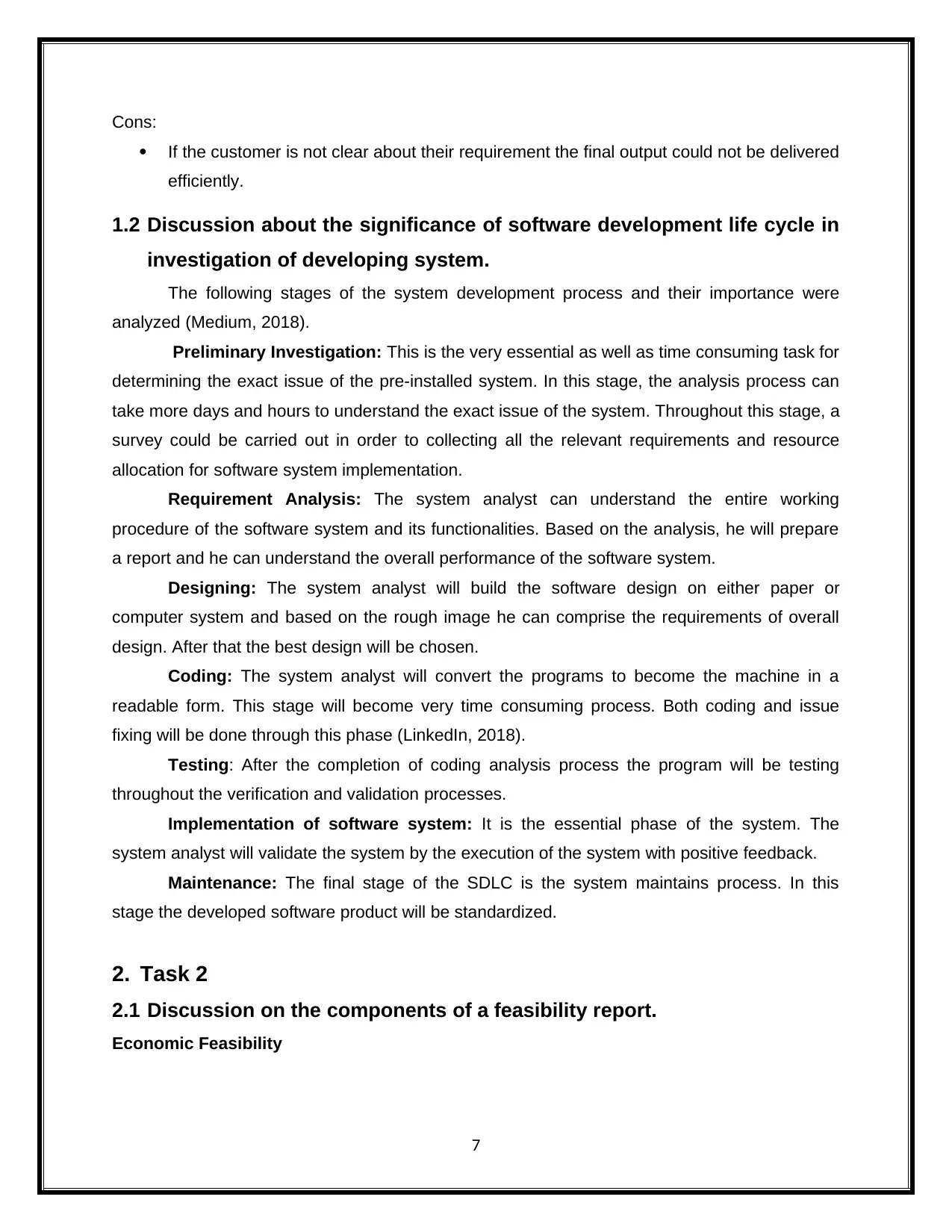
Cons:
If the customer is not clear about their requirement the final output could not be delivered
efficiently.
1.2 Discussion about the significance of software development life cycle in
investigation of developing system.
The following stages of the system development process and their importance were
analyzed (Medium, 2018).
Preliminary Investigation: This is the very essential as well as time consuming task for
determining the exact issue of the pre-installed system. In this stage, the analysis process can
take more days and hours to understand the exact issue of the system. Throughout this stage, a
survey could be carried out in order to collecting all the relevant requirements and resource
allocation for software system implementation.
Requirement Analysis: The system analyst can understand the entire working
procedure of the software system and its functionalities. Based on the analysis, he will prepare
a report and he can understand the overall performance of the software system.
Designing: The system analyst will build the software design on either paper or
computer system and based on the rough image he can comprise the requirements of overall
design. After that the best design will be chosen.
Coding: The system analyst will convert the programs to become the machine in a
readable form. This stage will become very time consuming process. Both coding and issue
fixing will be done through this phase (LinkedIn, 2018).
Testing: After the completion of coding analysis process the program will be testing
throughout the verification and validation processes.
Implementation of software system: It is the essential phase of the system. The
system analyst will validate the system by the execution of the system with positive feedback.
Maintenance: The final stage of the SDLC is the system maintains process. In this
stage the developed software product will be standardized.
2. Task 2
2.1 Discussion on the components of a feasibility report.
Economic Feasibility
7
If the customer is not clear about their requirement the final output could not be delivered
efficiently.
1.2 Discussion about the significance of software development life cycle in
investigation of developing system.
The following stages of the system development process and their importance were
analyzed (Medium, 2018).
Preliminary Investigation: This is the very essential as well as time consuming task for
determining the exact issue of the pre-installed system. In this stage, the analysis process can
take more days and hours to understand the exact issue of the system. Throughout this stage, a
survey could be carried out in order to collecting all the relevant requirements and resource
allocation for software system implementation.
Requirement Analysis: The system analyst can understand the entire working
procedure of the software system and its functionalities. Based on the analysis, he will prepare
a report and he can understand the overall performance of the software system.
Designing: The system analyst will build the software design on either paper or
computer system and based on the rough image he can comprise the requirements of overall
design. After that the best design will be chosen.
Coding: The system analyst will convert the programs to become the machine in a
readable form. This stage will become very time consuming process. Both coding and issue
fixing will be done through this phase (LinkedIn, 2018).
Testing: After the completion of coding analysis process the program will be testing
throughout the verification and validation processes.
Implementation of software system: It is the essential phase of the system. The
system analyst will validate the system by the execution of the system with positive feedback.
Maintenance: The final stage of the SDLC is the system maintains process. In this
stage the developed software product will be standardized.
2. Task 2
2.1 Discussion on the components of a feasibility report.
Economic Feasibility
7
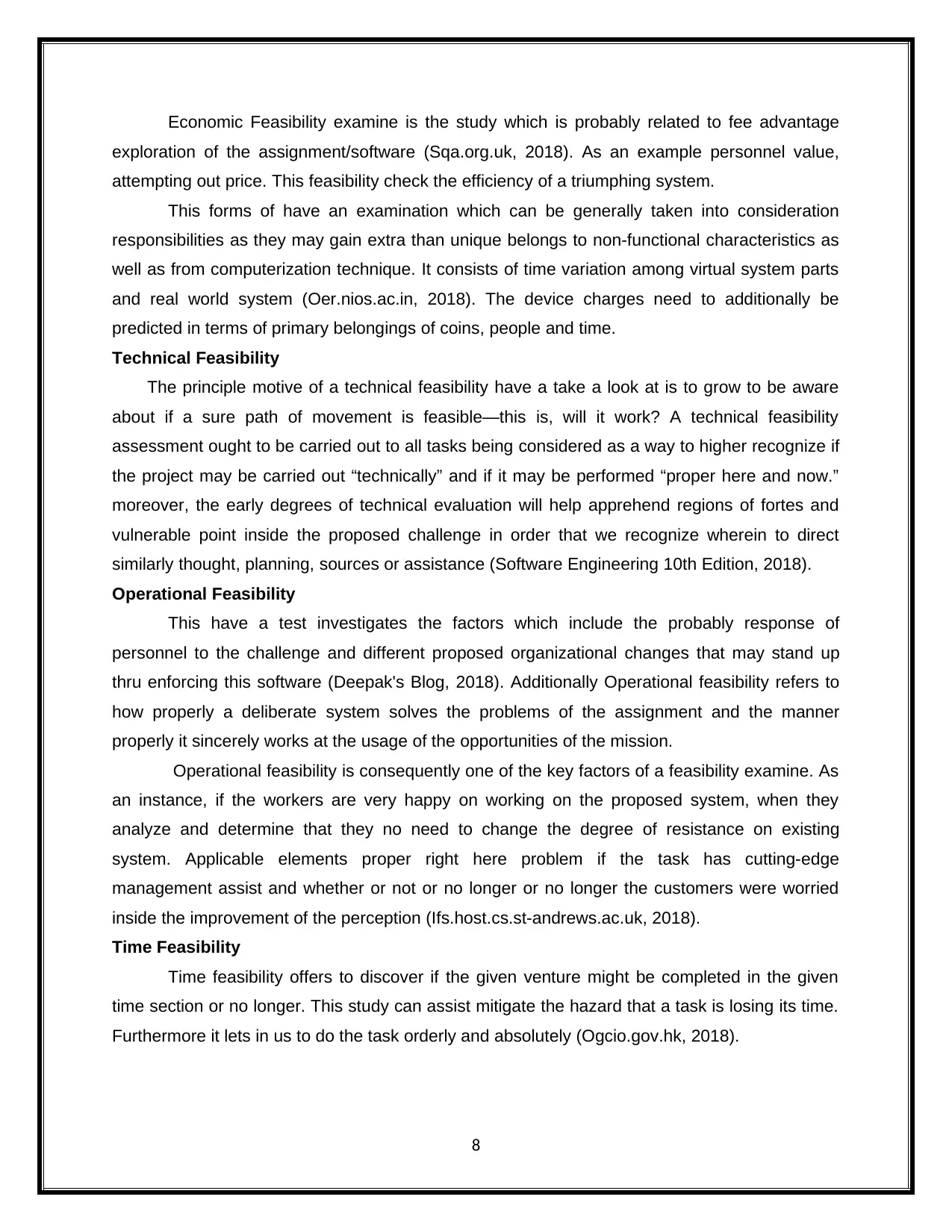
Economic Feasibility examine is the study which is probably related to fee advantage
exploration of the assignment/software (Sqa.org.uk, 2018). As an example personnel value,
attempting out price. This feasibility check the efficiency of a triumphing system.
This forms of have an examination which can be generally taken into consideration
responsibilities as they may gain extra than unique belongs to non-functional characteristics as
well as from computerization technique. It consists of time variation among virtual system parts
and real world system (Oer.nios.ac.in, 2018). The device charges need to additionally be
predicted in terms of primary belongings of coins, people and time.
Technical Feasibility
The principle motive of a technical feasibility have a take a look at is to grow to be aware
about if a sure path of movement is feasible—this is, will it work? A technical feasibility
assessment ought to be carried out to all tasks being considered as a way to higher recognize if
the project may be carried out “technically” and if it may be performed “proper here and now.”
moreover, the early degrees of technical evaluation will help apprehend regions of fortes and
vulnerable point inside the proposed challenge in order that we recognize wherein to direct
similarly thought, planning, sources or assistance (Software Engineering 10th Edition, 2018).
Operational Feasibility
This have a test investigates the factors which include the probably response of
personnel to the challenge and different proposed organizational changes that may stand up
thru enforcing this software (Deepak's Blog, 2018). Additionally Operational feasibility refers to
how properly a deliberate system solves the problems of the assignment and the manner
properly it sincerely works at the usage of the opportunities of the mission.
Operational feasibility is consequently one of the key factors of a feasibility examine. As
an instance, if the workers are very happy on working on the proposed system, when they
analyze and determine that they no need to change the degree of resistance on existing
system. Applicable elements proper right here problem if the task has cutting-edge
management assist and whether or not or no longer or no longer the customers were worried
inside the improvement of the perception (Ifs.host.cs.st-andrews.ac.uk, 2018).
Time Feasibility
Time feasibility offers to discover if the given venture might be completed in the given
time section or no longer. This study can assist mitigate the hazard that a task is losing its time.
Furthermore it lets in us to do the task orderly and absolutely (Ogcio.gov.hk, 2018).
8
exploration of the assignment/software (Sqa.org.uk, 2018). As an example personnel value,
attempting out price. This feasibility check the efficiency of a triumphing system.
This forms of have an examination which can be generally taken into consideration
responsibilities as they may gain extra than unique belongs to non-functional characteristics as
well as from computerization technique. It consists of time variation among virtual system parts
and real world system (Oer.nios.ac.in, 2018). The device charges need to additionally be
predicted in terms of primary belongings of coins, people and time.
Technical Feasibility
The principle motive of a technical feasibility have a take a look at is to grow to be aware
about if a sure path of movement is feasible—this is, will it work? A technical feasibility
assessment ought to be carried out to all tasks being considered as a way to higher recognize if
the project may be carried out “technically” and if it may be performed “proper here and now.”
moreover, the early degrees of technical evaluation will help apprehend regions of fortes and
vulnerable point inside the proposed challenge in order that we recognize wherein to direct
similarly thought, planning, sources or assistance (Software Engineering 10th Edition, 2018).
Operational Feasibility
This have a test investigates the factors which include the probably response of
personnel to the challenge and different proposed organizational changes that may stand up
thru enforcing this software (Deepak's Blog, 2018). Additionally Operational feasibility refers to
how properly a deliberate system solves the problems of the assignment and the manner
properly it sincerely works at the usage of the opportunities of the mission.
Operational feasibility is consequently one of the key factors of a feasibility examine. As
an instance, if the workers are very happy on working on the proposed system, when they
analyze and determine that they no need to change the degree of resistance on existing
system. Applicable elements proper right here problem if the task has cutting-edge
management assist and whether or not or no longer or no longer the customers were worried
inside the improvement of the perception (Ifs.host.cs.st-andrews.ac.uk, 2018).
Time Feasibility
Time feasibility offers to discover if the given venture might be completed in the given
time section or no longer. This study can assist mitigate the hazard that a task is losing its time.
Furthermore it lets in us to do the task orderly and absolutely (Ogcio.gov.hk, 2018).
8
⊘ This is a preview!⊘
Do you want full access?
Subscribe today to unlock all pages.

Trusted by 1+ million students worldwide
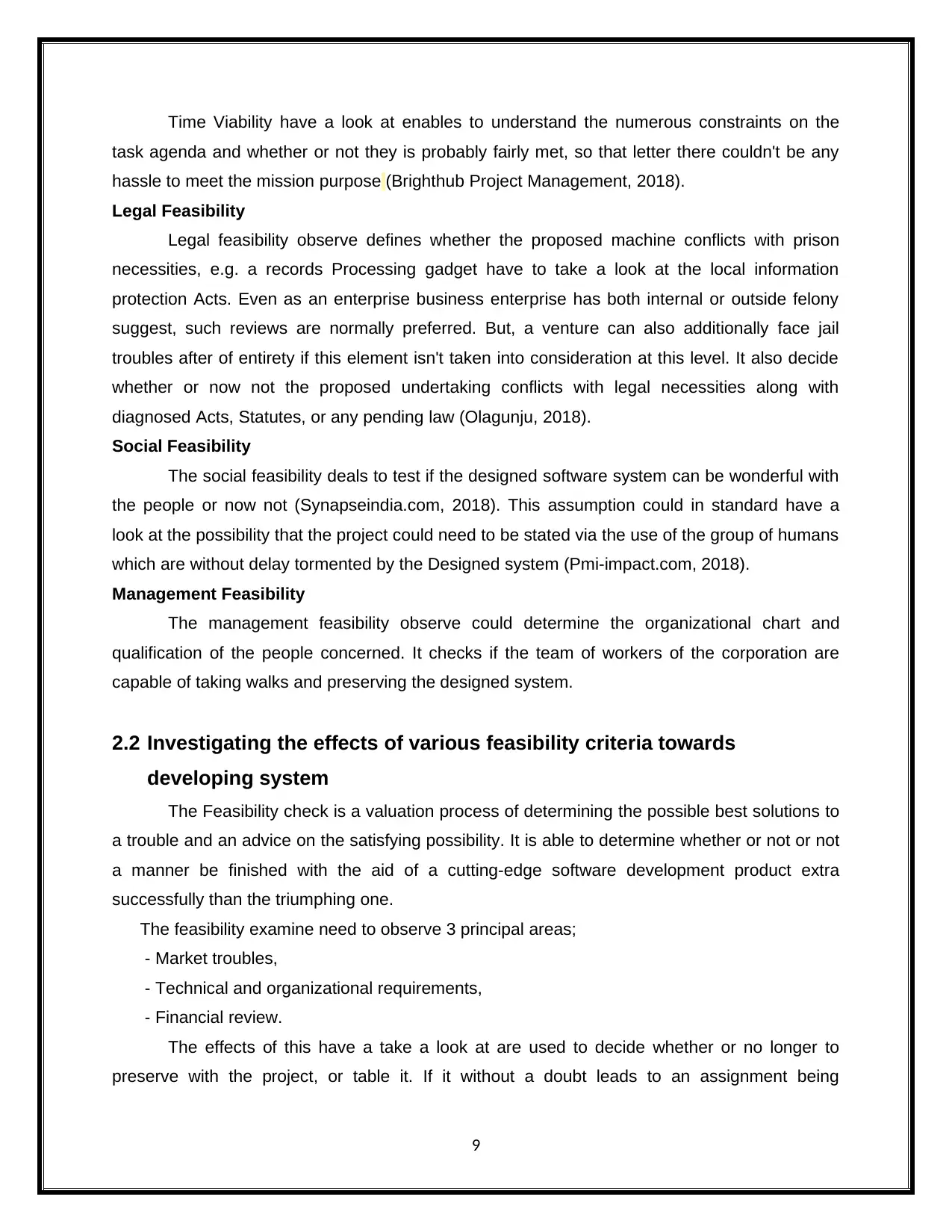
Time Viability have a look at enables to understand the numerous constraints on the
task agenda and whether or not they is probably fairly met, so that letter there couldn't be any
hassle to meet the mission purpose (Brighthub Project Management, 2018).
Legal Feasibility
Legal feasibility observe defines whether the proposed machine conflicts with prison
necessities, e.g. a records Processing gadget have to take a look at the local information
protection Acts. Even as an enterprise business enterprise has both internal or outside felony
suggest, such reviews are normally preferred. But, a venture can also additionally face jail
troubles after of entirety if this element isn't taken into consideration at this level. It also decide
whether or now not the proposed undertaking conflicts with legal necessities along with
diagnosed Acts, Statutes, or any pending law (Olagunju, 2018).
Social Feasibility
The social feasibility deals to test if the designed software system can be wonderful with
the people or now not (Synapseindia.com, 2018). This assumption could in standard have a
look at the possibility that the project could need to be stated via the use of the group of humans
which are without delay tormented by the Designed system (Pmi-impact.com, 2018).
Management Feasibility
The management feasibility observe could determine the organizational chart and
qualification of the people concerned. It checks if the team of workers of the corporation are
capable of taking walks and preserving the designed system.
2.2 Investigating the effects of various feasibility criteria towards
developing system
The Feasibility check is a valuation process of determining the possible best solutions to
a trouble and an advice on the satisfying possibility. It is able to determine whether or not or not
a manner be finished with the aid of a cutting-edge software development product extra
successfully than the triumphing one.
The feasibility examine need to observe 3 principal areas;
- Market troubles,
- Technical and organizational requirements,
- Financial review.
The effects of this have a take a look at are used to decide whether or no longer to
preserve with the project, or table it. If it without a doubt leads to an assignment being
9
task agenda and whether or not they is probably fairly met, so that letter there couldn't be any
hassle to meet the mission purpose (Brighthub Project Management, 2018).
Legal Feasibility
Legal feasibility observe defines whether the proposed machine conflicts with prison
necessities, e.g. a records Processing gadget have to take a look at the local information
protection Acts. Even as an enterprise business enterprise has both internal or outside felony
suggest, such reviews are normally preferred. But, a venture can also additionally face jail
troubles after of entirety if this element isn't taken into consideration at this level. It also decide
whether or now not the proposed undertaking conflicts with legal necessities along with
diagnosed Acts, Statutes, or any pending law (Olagunju, 2018).
Social Feasibility
The social feasibility deals to test if the designed software system can be wonderful with
the people or now not (Synapseindia.com, 2018). This assumption could in standard have a
look at the possibility that the project could need to be stated via the use of the group of humans
which are without delay tormented by the Designed system (Pmi-impact.com, 2018).
Management Feasibility
The management feasibility observe could determine the organizational chart and
qualification of the people concerned. It checks if the team of workers of the corporation are
capable of taking walks and preserving the designed system.
2.2 Investigating the effects of various feasibility criteria towards
developing system
The Feasibility check is a valuation process of determining the possible best solutions to
a trouble and an advice on the satisfying possibility. It is able to determine whether or not or not
a manner be finished with the aid of a cutting-edge software development product extra
successfully than the triumphing one.
The feasibility examine need to observe 3 principal areas;
- Market troubles,
- Technical and organizational requirements,
- Financial review.
The effects of this have a take a look at are used to decide whether or no longer to
preserve with the project, or table it. If it without a doubt leads to an assignment being
9
Paraphrase This Document
Need a fresh take? Get an instant paraphrase of this document with our AI Paraphraser
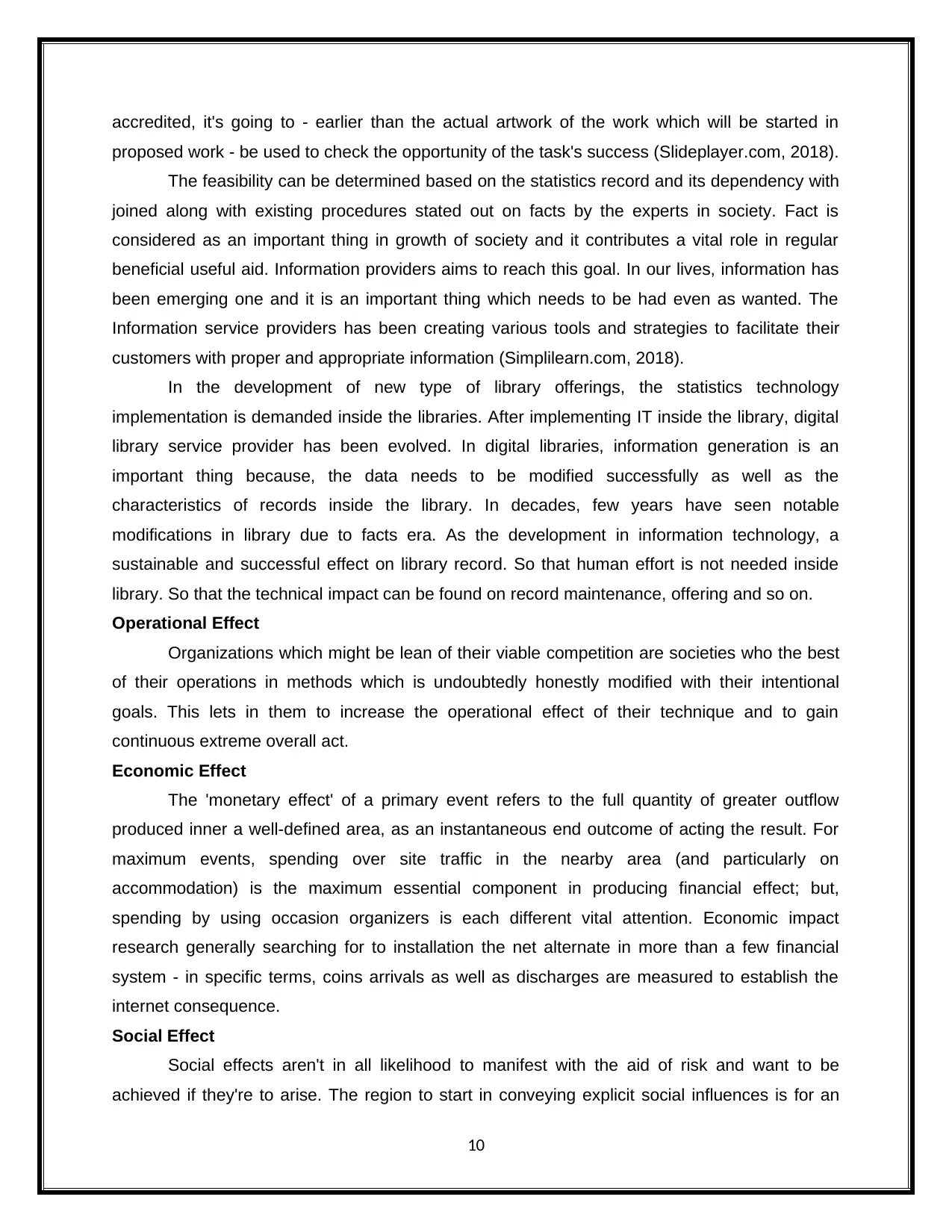
accredited, it's going to - earlier than the actual artwork of the work which will be started in
proposed work - be used to check the opportunity of the task's success (Slideplayer.com, 2018).
The feasibility can be determined based on the statistics record and its dependency with
joined along with existing procedures stated out on facts by the experts in society. Fact is
considered as an important thing in growth of society and it contributes a vital role in regular
beneficial useful aid. Information providers aims to reach this goal. In our lives, information has
been emerging one and it is an important thing which needs to be had even as wanted. The
Information service providers has been creating various tools and strategies to facilitate their
customers with proper and appropriate information (Simplilearn.com, 2018).
In the development of new type of library offerings, the statistics technology
implementation is demanded inside the libraries. After implementing IT inside the library, digital
library service provider has been evolved. In digital libraries, information generation is an
important thing because, the data needs to be modified successfully as well as the
characteristics of records inside the library. In decades, few years have seen notable
modifications in library due to facts era. As the development in information technology, a
sustainable and successful effect on library record. So that human effort is not needed inside
library. So that the technical impact can be found on record maintenance, offering and so on.
Operational Effect
Organizations which might be lean of their viable competition are societies who the best
of their operations in methods which is undoubtedly honestly modified with their intentional
goals. This lets in them to increase the operational effect of their technique and to gain
continuous extreme overall act.
Economic Effect
The 'monetary effect' of a primary event refers to the full quantity of greater outflow
produced inner a well-defined area, as an instantaneous end outcome of acting the result. For
maximum events, spending over site traffic in the nearby area (and particularly on
accommodation) is the maximum essential component in producing financial effect; but,
spending by using occasion organizers is each different vital attention. Economic impact
research generally searching for to installation the net alternate in more than a few financial
system - in specific terms, coins arrivals as well as discharges are measured to establish the
internet consequence.
Social Effect
Social effects aren't in all likelihood to manifest with the aid of risk and want to be
achieved if they're to arise. The region to start in conveying explicit social influences is for an
10
proposed work - be used to check the opportunity of the task's success (Slideplayer.com, 2018).
The feasibility can be determined based on the statistics record and its dependency with
joined along with existing procedures stated out on facts by the experts in society. Fact is
considered as an important thing in growth of society and it contributes a vital role in regular
beneficial useful aid. Information providers aims to reach this goal. In our lives, information has
been emerging one and it is an important thing which needs to be had even as wanted. The
Information service providers has been creating various tools and strategies to facilitate their
customers with proper and appropriate information (Simplilearn.com, 2018).
In the development of new type of library offerings, the statistics technology
implementation is demanded inside the libraries. After implementing IT inside the library, digital
library service provider has been evolved. In digital libraries, information generation is an
important thing because, the data needs to be modified successfully as well as the
characteristics of records inside the library. In decades, few years have seen notable
modifications in library due to facts era. As the development in information technology, a
sustainable and successful effect on library record. So that human effort is not needed inside
library. So that the technical impact can be found on record maintenance, offering and so on.
Operational Effect
Organizations which might be lean of their viable competition are societies who the best
of their operations in methods which is undoubtedly honestly modified with their intentional
goals. This lets in them to increase the operational effect of their technique and to gain
continuous extreme overall act.
Economic Effect
The 'monetary effect' of a primary event refers to the full quantity of greater outflow
produced inner a well-defined area, as an instantaneous end outcome of acting the result. For
maximum events, spending over site traffic in the nearby area (and particularly on
accommodation) is the maximum essential component in producing financial effect; but,
spending by using occasion organizers is each different vital attention. Economic impact
research generally searching for to installation the net alternate in more than a few financial
system - in specific terms, coins arrivals as well as discharges are measured to establish the
internet consequence.
Social Effect
Social effects aren't in all likelihood to manifest with the aid of risk and want to be
achieved if they're to arise. The region to start in conveying explicit social influences is for an
10
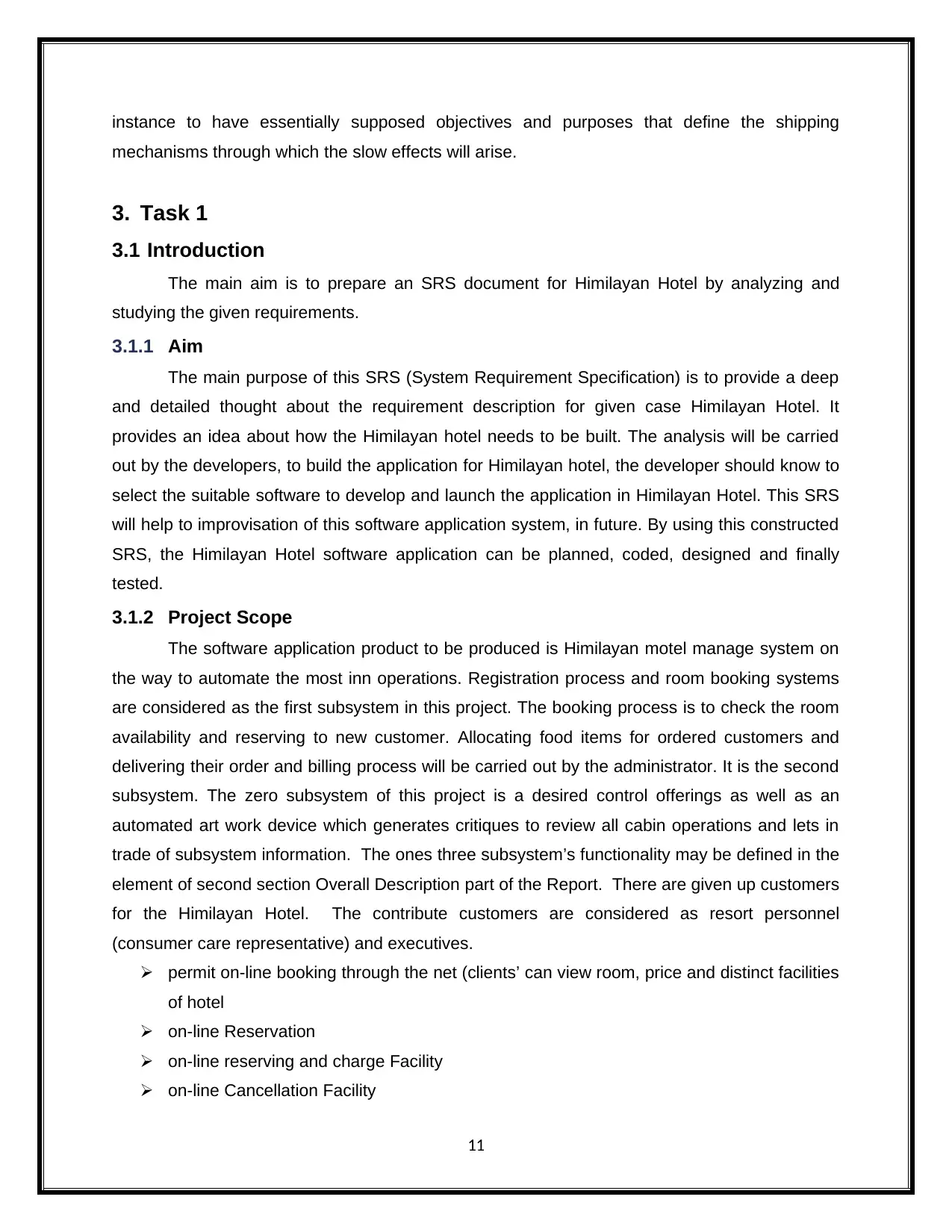
instance to have essentially supposed objectives and purposes that define the shipping
mechanisms through which the slow effects will arise.
3. Task 1
3.1 Introduction
The main aim is to prepare an SRS document for Himilayan Hotel by analyzing and
studying the given requirements.
3.1.1 Aim
The main purpose of this SRS (System Requirement Specification) is to provide a deep
and detailed thought about the requirement description for given case Himilayan Hotel. It
provides an idea about how the Himilayan hotel needs to be built. The analysis will be carried
out by the developers, to build the application for Himilayan hotel, the developer should know to
select the suitable software to develop and launch the application in Himilayan Hotel. This SRS
will help to improvisation of this software application system, in future. By using this constructed
SRS, the Himilayan Hotel software application can be planned, coded, designed and finally
tested.
3.1.2 Project Scope
The software application product to be produced is Himilayan motel manage system on
the way to automate the most inn operations. Registration process and room booking systems
are considered as the first subsystem in this project. The booking process is to check the room
availability and reserving to new customer. Allocating food items for ordered customers and
delivering their order and billing process will be carried out by the administrator. It is the second
subsystem. The zero subsystem of this project is a desired control offerings as well as an
automated art work device which generates critiques to review all cabin operations and lets in
trade of subsystem information. The ones three subsystem’s functionality may be defined in the
element of second section Overall Description part of the Report. There are given up customers
for the Himilayan Hotel. The contribute customers are considered as resort personnel
(consumer care representative) and executives.
permit on-line booking through the net (clients’ can view room, price and distinct facilities
of hotel
on-line Reservation
on-line reserving and charge Facility
on-line Cancellation Facility
11
mechanisms through which the slow effects will arise.
3. Task 1
3.1 Introduction
The main aim is to prepare an SRS document for Himilayan Hotel by analyzing and
studying the given requirements.
3.1.1 Aim
The main purpose of this SRS (System Requirement Specification) is to provide a deep
and detailed thought about the requirement description for given case Himilayan Hotel. It
provides an idea about how the Himilayan hotel needs to be built. The analysis will be carried
out by the developers, to build the application for Himilayan hotel, the developer should know to
select the suitable software to develop and launch the application in Himilayan Hotel. This SRS
will help to improvisation of this software application system, in future. By using this constructed
SRS, the Himilayan Hotel software application can be planned, coded, designed and finally
tested.
3.1.2 Project Scope
The software application product to be produced is Himilayan motel manage system on
the way to automate the most inn operations. Registration process and room booking systems
are considered as the first subsystem in this project. The booking process is to check the room
availability and reserving to new customer. Allocating food items for ordered customers and
delivering their order and billing process will be carried out by the administrator. It is the second
subsystem. The zero subsystem of this project is a desired control offerings as well as an
automated art work device which generates critiques to review all cabin operations and lets in
trade of subsystem information. The ones three subsystem’s functionality may be defined in the
element of second section Overall Description part of the Report. There are given up customers
for the Himilayan Hotel. The contribute customers are considered as resort personnel
(consumer care representative) and executives.
permit on-line booking through the net (clients’ can view room, price and distinct facilities
of hotel
on-line Reservation
on-line reserving and charge Facility
on-line Cancellation Facility
11
⊘ This is a preview!⊘
Do you want full access?
Subscribe today to unlock all pages.

Trusted by 1+ million students worldwide
1 out of 25
Related Documents
Your All-in-One AI-Powered Toolkit for Academic Success.
+13062052269
info@desklib.com
Available 24*7 on WhatsApp / Email
![[object Object]](/_next/static/media/star-bottom.7253800d.svg)
Unlock your academic potential
Copyright © 2020–2025 A2Z Services. All Rights Reserved. Developed and managed by ZUCOL.





